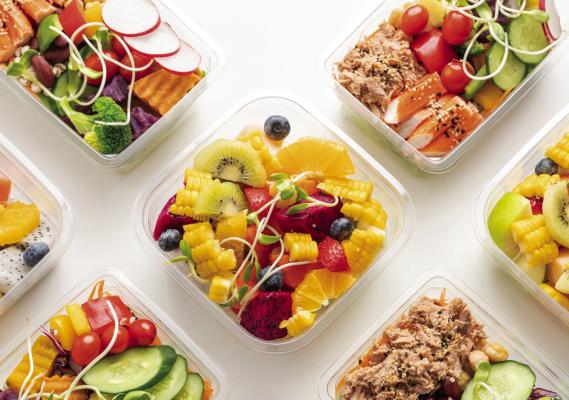Health in the New Year
‘Tis the season when we all think about resolutions for the new year. The top ones include losing weight and exercising more. But after a few weeks, it seems we lose the drive to keep those new goals.
The key is to focus on a few goals at a time, taking small steps. Instead of a New Year’s goal, set an every-Monday goal.
Here are a few other tips from the Academy of Nutrition and Dietetics on how to keep those goals: --Offer regular meals throughout the day, including a variety of nutrient-rich foods. Try starting the day with a healthful breakfast, such as oatmeal with fruit, nuts and low-fat milk or yogurt. Encourage balanced choices at lunch or help pack a brown bag to take. Promote a supportive environment and get everyone together for dinnertime at least a few times a week.
--Remember to put the focus on health, not weight. Kids and teenagers are very observant and tend to repeat things they hear or see. Try to avoid making comments about your weight in front of them, as it can overemphasize looks and undervalue health.
--Encourage a healthy eating style by following the U.S. Department of Agriculture’s MyPlate recommendations at meals. Aim to make half your plate fruits and vegetables, a quarter grains and the remaining quarter lean protein, along with a serving of low-fat or fat-free dairy.
--Get active. Add physical activity into your day whenever you can, whether it’s taking a family walk after dinner or joining the gym. Fitness centers often offer group classes for kids, such as swimming or dance. Remember, children and teens should get at least 60 minutes of physical activity per day, and adults should get 2 1/2 hours per week.
--Reduce your family’s risk of food poisoning by encouraging good food safety habits, such as washing hands before every meal. Having kids and teens help in the kitchen can also be a great way to teach them about food safety.
--Stay positive. Even if you struggle to work in physical activity or to finish your vegetables, set a good example. Your child is listening to everything you say, even if you think they’re ignoring you.
Q and A
Q: What are sugar alcohols and how are they used?
A: Sugar alcohols occur naturally in some fruits and vegetables and are also a man-made ingredient commonly used as a substitute for sugar in foods. Despite their name, they do not contain ethanol, found in alcoholic beverages. Their chemical structure looks similar to the chemical structures of sugar and alcohol, hence the name. There are a number of different sugar alcohols used in products like gum, jelly spreads, beverages, candy and toothpaste. If you read nutrition labels, you will most often find the sugar alcohols xylitol, erythritol, sorbitol or maltitol listed in the ingredients. Sugar alcohols contain fewer calories than sugar and are only partially digested, so they have less of an effect on blood sugars. Sugar alcohols can help prevent tooth decay, and they exert benefits on the gut. Sugar alcohols in food also add texture and moisture and prevent browning when heated. If consumed in large amounts, sugar alcohols may contribute to gas, bloating and diarrhea. Just like sugar alcohols differ in their calories and tastes, they also differ in how much GI distress they cause.
Information courtesy of Environmental Nutrition.
RECIPE
Walnuts are the only nut significantly high in ALA omega-3s, which are essential fatty acids critical to various bodily processes. Here’s an ultra-nutritious, ultraeasy dip with toasted walnuts that’s easy to prepare and makes a great snack or appetizer. Serve it with fresh vegetables and whole-wheat pita chips.
ZESTY WALNUT HUMMUS
1/2 cup walnuts, toasted
1 can (19 ounces) chickpeas (drained and rinsed)
1/4 cup Italian salad dressing
1/2 teaspoon cayenne pepper In a blender or food processor, puree walnuts, chickpeas, salad dressing and cayenne pepper together until smooth.
Serve with vegetable sticks or pita triangles.
Serves 18. (Serving size: 2 tablespoons.)
Note: To toast walnuts in the oven, place walnuts in a single layer on parchment sheet on a baking tray and bake in a 350 F oven for 8 to 10 minutes. Shake during toasting to brown evenly. To brown on the stovetop, use a dry heavy skillet over medium heat. Stirring constantly, heat 1 to 2 minutes, until fragrant.
Per serving: 63 calories; 2 grams protein; 7 grams carbohydrates; 3 grams fat, 0 grams cholesterol; 1 gram fiber; 134 milligrams sodium.
Charlyn Fargo is a registered dietitian with SIU Med School in Springfield, Illinois. For comments or questions, contact her at charfarg@aol. com or follow her on Twitter @ NutritionRD. To find out more about Charlyn Fargo and read features by other Creators writers and cartoonists, visit the Creators website at www.creators.
com.

